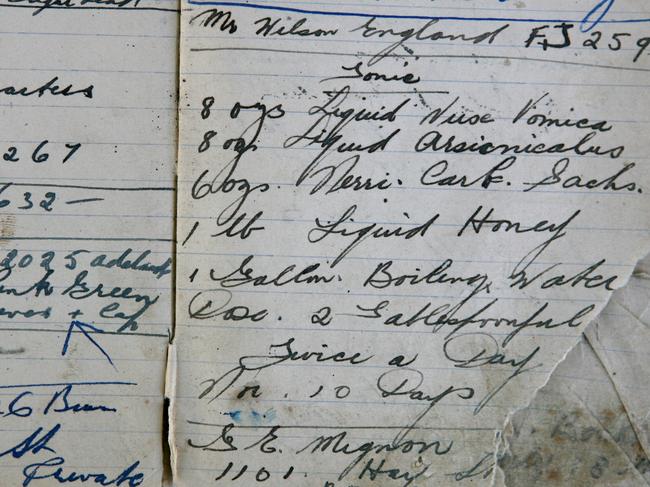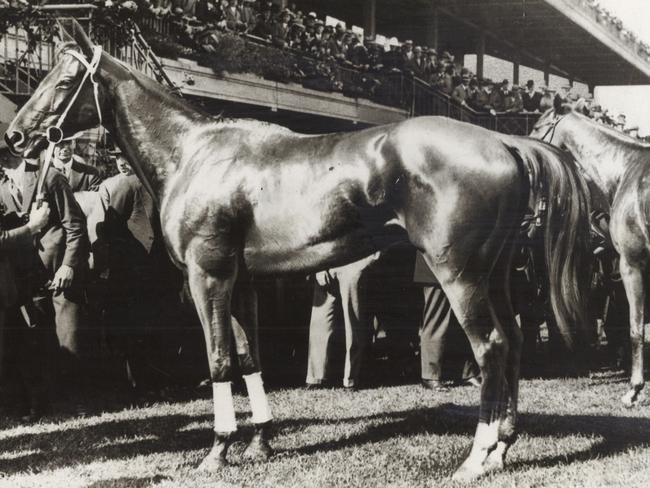How did Australia’s first champion racehorse Phar Lap really die
He was Australia’s most famous racehorse — but within days of arriving in the US, he was dead, and in extremely suspicious circumstances.
Sport
Don't miss out on the headlines from Sport. Followed categories will be added to My News.
On April 5, 1932, a blunt headline shocked a nation. “Phar Lap dead: collapse in California.”
The story explained how Phar Lap was “stricken this morning by symptoms of colic, which developed so rapidly that veterinary surgeons were unable to counteract the illness”.
Phar Lap had collapsed at the feet of his strapper, Tommy Woodcock, a man who had tasked himself with never leaving Phar Lap’s side while over in America.
“The illness of Phar Lap was kept a secret by the stable,” the paper reported, also claiming “rumours were current that the horse had been poisoned”. Although Woodcock, vet William Nielson, and jockey Billy Elliot all “emphatically discounted” this theory, others weren’t so sure.
Rumours continued to swirl that Phar Lap had been poisoned by an American gangster, who stood to lose big money if the Australian horse kept dominating the racing world. It sounds farfetched in 2019: A horse killed by mobsters. Only, Phar Lap was no regular horse. And he had survived two assassination attempts before.
WAS PHAR LAP POISONED?
In September 1936, almost four-and-a-half years after the untimely death, Phar Lap’s strapper Tommy Woodcock broke his silence to pen an explosive piece in Brisbane’s Courier Mail. In the story, Woodcock, detailed how a gangster he referred to as ‘The Brazilian’ was hanging around Phar Lap’s stables in both Mexico and in San Francisco, and later admitted to killing the prized horse.
“His life was in danger from the moment he landed in America,” Woodcock recalls, explaining how security measures around Phar Lap were unusually tight.
Woodcock vowed never to let the horse out of his sight, even putting a watchman in Phar Lap’s stable to monitor his food and water when the horse was out on the track exercising.
In addition, the Agua Caliente Club, where Phar Lap was to race, put a Mexican security guard with a loaded blunderbuss outside the barn to keep an around-the-clock vigil.
“Every precaution was taken for the champion’s safety,” Woodcock wrote. “The only feed used was brought from New Zealand, and I had water brought from Mexican Springs in five-gallon jars. It cost a dollar a bottle, and the horse never tasted a drop before one member of our party tested it.”

Woodcock recalls first seeing ‘The Brazilian’ hanging around the stables a few days before the race, and was warned “he had the reputation of being a killer.”
When he saw him again just before the race with “the toughest-looking bunch of men I have ever seen,” Woodcock asked an American trainer who they were. The trainer told him they were “a gang to be feared, who made racing a racket that paid, even at the expense of human life”.
They’d just witnessed Phar Lap walk into the enclosure with a split hoof, which had been bandaged up. “He was using the leg tenderly, and, of course, they didn’t fail to notice this.”
Despite the injury, Phar Lap won the Agua Caliente Handicap, and the gangsters were not pleased.
“There was a fearful din as he passed the post, and above it all,” Woodcock continued. “I heard angry words behind me. On looking round I saw the gang, and it was evident that someone was telling ‘The Brazilian’ off. The only words I caught were ... ‘Phar Lap won the race on three legs.’”
It was the last race he would ever run.
THE FATAL DOSE
Phar Lap and his team next travelled to San Francisco. Woodcock, who thought the danger had passed, was surprised when he again saw The Brazilian in San Francisco.
“Straightaway I was on my guard, and never left Phar Lap, although I must admit I did not think it necessary to police the barn while the horse was out exercising.”
This was a fatal mistake. A few days later, Woodcock entered the barn and found Phar Lap lying on his side, in distress. He fetched Phar Lap’s vet, William Nielson, and the pair tended to him into the afternoon.
Around 2pm, Phar Lap took his final breath.
“He whinnied. He groaned,” Woodcock remembered. “Dementedly, I rushed around to make him comfortable. Coming towards me, he nosed affectionately under my arm. Then something inside him burst.
“He drenched me in blood, and fell dead at my feet.”
Phar Lap was pronounced dead, with an autopsy a few hours later noting that the horse’s stomach and intestines were inflamed. The official verdict given to the press was colic. Woodcock thought otherwise.

“Human lives counted nothing to those of the doping gang, and the life of a horse meant less,” he wrote. “How my blood boils to think how little such a noble animal meant to the gang that sentenced Phar Lap to death. I can’t figure it out.”
Shaken by the tragedy, and scared by the illegal elements at play, Woodcock kept his suspicions to himself and kept busy preparing another racehorse. One day later, The Brazilian returned and entered the barn, evidently expecting to find someone else.
“I flew into a passion and rushed to the door,” Woodcock wrote, “but he scarcely heeded my outburst. ‘Get out, you murdering thief, or I’ll pitchfork you,’ I called out. With his right hand in his coat pocket, he entered the barn, and snarled: ‘Another word from you and I’ll drill you full of lead.’”
Woodcock backed away, tripped over a hay bale, and The Brazilian stood over him. According to Woodcock, he threatened “an early visit” if he heard him “squealing”, then delivered his parting words.
“I would have drilled you the night I fixed Phar Lap if you’d wakened.”
Woodcock admits after this cold admission, he was “on the verge of a breakdown.”
EARLY ASSASSINATION ATTEMPTS
Phar Lap had survived two assassination attempts in 1930, both of which occurred days before the 1930 Melbourne Cup.
The first attempt was crude: a truck rushed towards Phar Lap and Woodcock, as he was leading the horse in the street. As he pulled Phar Lap out of the path of danger, the truck came so close as to brush Woodcock. The second time, a car containing two men swerved around the corner and shot at the horse.
“I propped Bobby (his nickname for Phar Lap) against the fence so when they whizzed around the corner they had a pretty awkward shot,” he explained in 1983.
“They didn’t aim at his head, but down low at his feet, trying to cripple him. The shot hit the ground a yard in front of him.”
SCIENCE CATCHES UP TO PHAR LAP
Luckily, for the sake of historians and racing fans hoping to get to the bottom of this mystery, Phar Lap was stuffed and remains frozen in time at Museum Victoria in Melbourne.
This is how Associate Professor Ivan Kempson, from Taiwan’s Institute of Physics, managed to pluck a sample of hair from the back of Phar Lap’s neck, which he got tested at a lab in Chicago in 2010. Toxicity remains in the hair follicles, and the results showed that Phar Lap had arsenic in his system at the time of his death, with the dose having been administered roughly 35 hours before he died.
“All our observations are consistent with consumption of a large dose of arsenic,” Dr Kempson said.

“It definitely re-highlights the arsenic theory of death because it’s been quite debatable.”
The theory was ruled out upon the racehorse’s death, but it’s worth noting this was in 1932. Colic was believed to be the cause of his untimely demise, but rumours flew for years that he was murdered. Accidental poisoning was also floated as a theory; the autopsy made note of Phar Lap’s red intestines, which was interpreted as being caused by an irritant poison.
Another point of contention comes from the taxidermy process in the early 20th Century, during which arsenic was painted on the skin of the animals. To rule this out, Kempson tested other specimens which were known to have been preserved in this way. The chemical compounds were quite different, with Phar Lap proven to have ingested the arsenic rather than absorbed it after death.
“This is really the only physical evidence that exists on the cause of death and it is consistent with poisoning,” Dr Kempson explained.
“That just adds to the mystery rather than solves it,” Dr. Graeme Putt, a retired New Zealand physicist tells news.com.au. “The question is, where did the arsenic he detected almost 70 years following the horse’s death come from?”
OTHER THEORIES
Dr. Graeme Putt is somewhat of an authority on race horses. He wrote a research paper for Australian Physics on racehorse Black Caviar in 2013, helmed a theoretical study on Winx’s rapid stride, and co-authored the 2009 book Phar Lap — The Untold Story. He refers to the mafia conspiracy theory as “a deep sigh”.
“For me it is just too fanciful,” he told news.com.au.
He cited part-owner and trainer Harry Telford’s reaction to this theory, who asked: “What was to be gained from killing him? The big race was over, there was no betting on the next.” It’s a good point.

Putt explains how the post-mortem examination hours after death “revealed severe inflammation of the stomach and colon” and that when the vet arrived at the stables too late to help, he noted that Phar Lap’s stomach was distended by internal gas.
In recent years, Dr John van Veenendaal, a professional racetrack practitioner and specialist equine surgeon, and Dr Sally Church, a veterinary research scientist of the University of Melbourne, examined the anecdotal evidence given by Phar Lap’s handlers, plus the post-mortem results, and came to the opinion that Phar Lap died of interior enteritis, known in veterinary science as Duodenitis-Proximal Jejuntis, or DPJ.
“It was a disease unknown to veterinary science in 1932, that was not described in its professional literature until the 1980s,” Putt explains.
“This, in my opinion, still remains the most likely cause of death — natural causes,” he concludes.
He reasons that recent findings of arsenic in the horse hair might have been due to a tonic that involved arsenic in its preparation — common in the 1930s — being mistakenly prepared by Woodcock to alleviate Phar Lap’s DPJ. Putt stresses this is mere speculation.
“However, I think the conspiracy theory of Americans wilfully killing the horse is a furphy,” he continues.
“It is a flow-on from the belief early-20th-Century Australians held about the death of its iconic boxer Les Darcy as being poisoned by the Yanks while in America in search of a world champion boxing title. This is another furphy. Darcy died of septicaemia via a tooth infection.
“You cannot blame the Yanks for everything that goes wrong.”
Nathan Jolly is a freelance writer. Continue the conversation @nathanjolly
Originally published as How did Australia’s first champion racehorse Phar Lap really die


